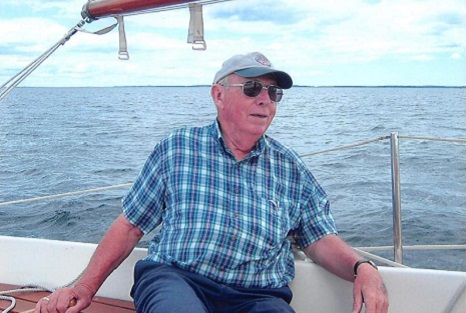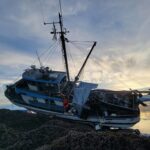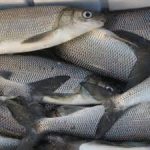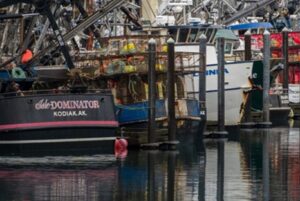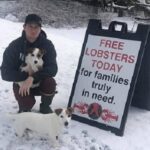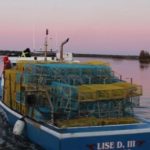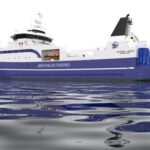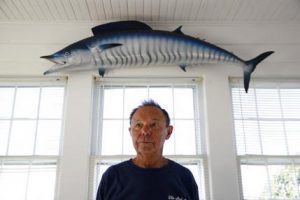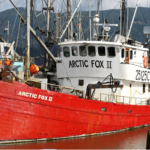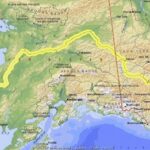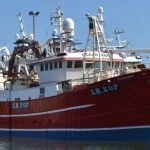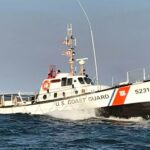Category Archives: Featured
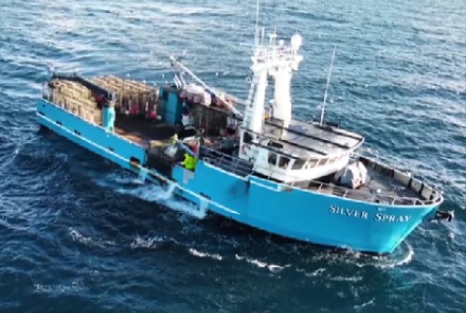
Another Bering Sea snow crab season closure brings more financial hardships for fishermen
“This is something that’s in our blood,” said Gabriel Prout, the owner and a deckhand of the 116-foot F/V Silver Spray. However, now his passion and family tradition is in jeopardy. On Oct. 6, the Alaska Department of Fish and Game announced it was closing the 2023-24 Bering Sea snow crab season for the second season in a row. “The stock is currently at all-time low levels from the survey time series,” said Ethan Nichols, the ADF&G acting area management biologist for the Bering Sea & Aleutian Islands region. “So, the threshold for opening is that total mature male biomass has to be at least 25% of long-term average. And in 2023 total mature male biomass is estimated to be between 15 and 19% of the long-term average.” The news felt like a punch to the gut for Prout, whose family relies on the season for 80 to 90% of its revenue. Video, >>click to read<< 11:40

Engineer Honored for Using a Power Block to Rescue Shipwreck Survivors
The engineer of the pair trawler F/V Guiding Light has been honored with a lifesaving trophy from the Shipwrecked Mariners’ Society for his quick thinking during the sinking of the vessel’s sister ship off the Shetland Islands last year. On the afternoon of October 6, 2022, the Peterhead-based fishing vessels F/V Guiding Star and F/V Guiding Light were located about 45 nm to the southeast of the Shetlands. Conditions were challenging, including rough seas and winds approaching gale force. At around noon, the vessels hauled in their catch and were retrieving their trawl gear when they collided. The bow of the F/V Guiding Light rose in a swell and struck F/V Guiding Star towards the stern, penetrating the hull and flooding an accommodations compartment. F/V Guiding Light’s first engineer, Kriss Leel, moved quickly to respond, starting up the deck crane and making heaving lines ready. >>click to read<< 12:49
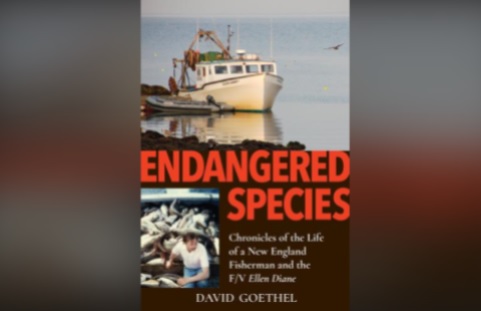
A fisherman’s view of the state of commercial fishing
If the control cord for the hoist at the Hampton State Pier had been the correct length and David Goethel had not lost his balance in reaching for it and had not fallen head-first to the floating dock 20 feet below, we may have never had the chance to read “Endangered Species,” just out from Peter Randall Publishing. That would be a shame. Goethel’s memoir of his life as a commercial fisherman on the Atlantic Ocean is by turns funny, scary, and educational. You may wince as he tells of the rough times and seas that fishermen sometimes face, where a high wave can cause a sharp knife to be impaled in one’s leg. It happened to Goethel, whose oldest son, Eric, had to use the Boy Scout life-saving skills he had just learned to help stop the bleeding. You may feel as frustrated as does Goethel when federal government and non-governmental actors force rules and regulations that make no sense and where the bureaucrats are dismissive of the fishermen who — spoiler alert — actually do know something about fishing and fish. >>click to read<< 08:07

Beached fishing boat recovered
The fishing vessel Judy is floating again after a salvage attempt caused it to crash into the south Jetty and flip onto its side twice. The Judy was reported aground in the sand south of the South Jetty on Sept. 18. Since then, owners made several attempts to refloat the vessel at high tide but were unsuccessful. At the salvage site, one could see two US Coast Guard motor lifeboats at the end of the bar, and the 102-foot tugboat Noelani about 1/3 of a mile out with a long, buoyed line connecting it to the Judy. O as the Judy began to inch forward, eventually floating upright as floated away from the shore. However, as it was being pulled, the Judy began to move precariously nearer to the south Jetty. The tug could be seen moving south to counter the move but when tension was applied to the tow line, the Judy veered right and hit the rocks. 3 photos, >>click to read<< 15:00

Hard-hit Bayou La Batre shrimpers say they need all the help they can get
Shrimpers say this is the best time of the year to harvest the crustaceans, but most of the shrimp boats in this seafood capital are tied up on the docks these days. James Mason, who has fished his entire life, said it simply isn’t profitable to go hunting for shrimp. “Haven’t been out in a year,” he said. The Wilmer resident said that to make ends meet, he has been working at a shipyard not far from where the Capt. Mason sits idle. He said he even tried working for a month on an oyster boat in New Jersey. Sen. Tommy Tuberville (R-Auburn) last month offered legislation that would create a task force to monitor foreign subsidies of shrimp and other agricultural products. He said he hopes that would greatly speed up enforcement. “We need some help, and I’m talking about urgent help,” he said. “If we don’t get some help, I don’t’ know if we’ll survive.” Added Mason: “Everybody in this bayou is hurting. Everybody. It doesn’t matter who it is.” Video, >>click to read<< 11:46
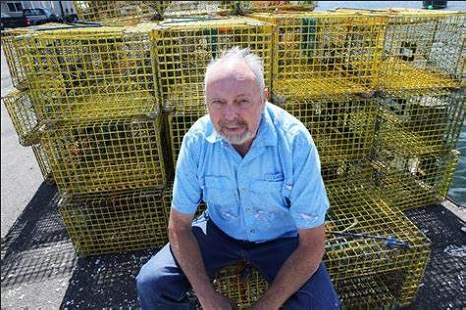
‘We are the endangered species’: Hampton fisherman David Goethel shares story in new book
For 40 years, David Goethel rode his 44-foot fish trawler the Ellen Diane from Hampton-Seabrook Harbor to Jeffreys Ledge off the coast of New Hampshire. His new book “Endangered Species,” published by Peter Randall of Portsmouth, shares his life story as well as a warning that today’s federal regulations are putting small boats out of business. “We are the endangered species,” Goethel said. Goethel, 69, retired last year to focus on treatment for cancer that is now in remission. A voice for the New Hampshire fishing community, Goethel said he was encouraged by his son to write his story so future generations can learn how small-boat trawlers were brought to the brink of extinction. “So that when that happens, they’ll at least have some accurate portrayals of lives,” Goethel said. “But also how they ended up in that position.” Photos, >>click to read<< 07:46
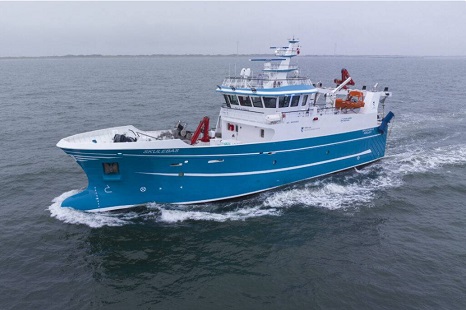
Corvus to Equip First Hydrogen/electric Hybrid Fishing and Training Vessel
Corvus Energy, a company providing zero-emission solutions for the maritime industry, said Monday it had won a contract with Hvide Sande Shipyard in Denmark to supply a complete hydrogen fuel cell system for the training vessel “MS Skulebas.” “The 35-meter fishing and training vessel has the latest technology and commercial fishing systems installed and sets an example of innovation and cooperation within the maritime and education sectors. The vessel, which is owned by Vestland County and operated by Måløy Upper Secondary School, will be the first of its kind, combining both fuel cells and batteries in a fishing vessel,” Corvus Energy said. >>click to read<< 12:53
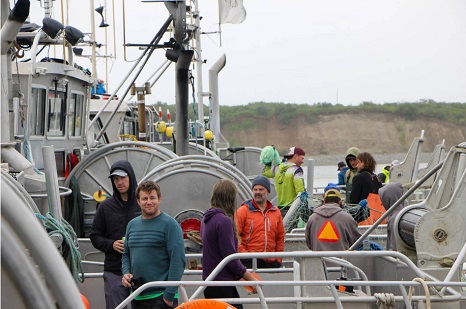
A 50-year situation: the market dynamic between fishing fleets and processors in Bristol Bay
This year, Bristol Bay’s 50 cents per pound base price had fleet members questioning the industry’s longevity. The dynamic between fleets and processors has existed for decades, with permit-holding fishing crews delivering their catch before knowing its cost, and processors relying on them to do so. KDLG’s Christina McDermott sat down with economist Gunnar Knapp, who spent decades studying Bristol Bay’s salmon markets, to learn more about the history of this relationship, and what it means going forward. Christina McDermott: Just a little background: this past summer, many fleet members were upset when the price was announced at 50 cents per pound, which is the lowest in the past 40 years when adjusted for inflation. The announcement came fairly late in the season. There was protest, and there was a lot of discussion on the processors’ respective power to set that price. And I’m interested in going back a little bit. What opportunities [did] the fleet have to sell their fish 50 years ago, let’s say, or 20 years ago? Has it always [been] this relationship [that] there are these processors and there are these fishermen? >>click to read<< 10:00
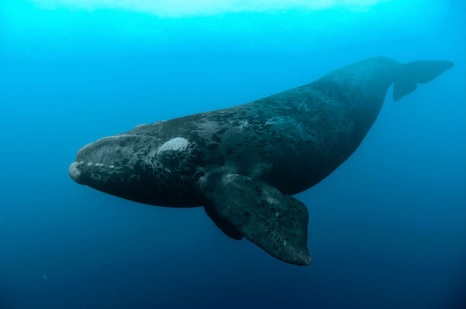
Biden Administration Is Killing Whales and Covering it Up
The Biden Administration is rushing headlong to start the massive construction of offshore wind power projects off the East Coast. The wind industry calls these installations “farms.” In no way, shape, or form do they resemble bucolic farms. Fortunately, several citizen groups have been formed which are vigorously opposing this massive industrialization of the ocean. The two leading organizations are Save Right Whales Coalition, lead by Lisa Linowes, and Save Long Beach Island, lead by Dr. Robert Stern. In addition, Michael Shellenberger has produced a terrific documentary, Thrown to the Wind, which provides an eye-opening view into the real world of noise produced by so called survey ships. Save LBI has also initiated litigation in New Jersey federal court seeking to revoke the permits issued by the Bureau of Ocean Energy Management (BOEM) authorizing this pre-construction activity. By Collister Johnson. >>click to read<< 09:26
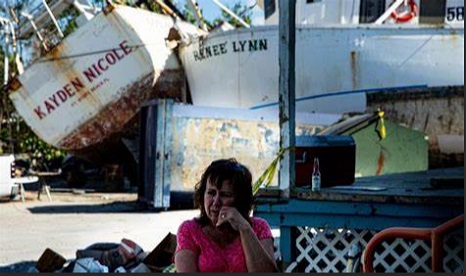
Longtime Fort Myers Beach shrimping operation dissolving after disputes between owners
As the Fort Myers Beach shrimping industry claws its way back after Ian, one of the last remaining companies on the historic waterfront is not returning, though the end of Trico Shrimp Company is not due to the hurricane. The demise of Trico Shrimp reduces the size of the historic “pink gold” fleet as two local families with several decades of business history part ways. The partnership splintered over how the shrimping operations were run, court records show. The directors of Trico Shrimp, incorporated in 1986, have been ensnared in legal action since 2021 when Dennis Henderson and wife Ranell Henderson filed for the dissolutions of various companies, including several shrimp boats, they own with wife-and-husband Christine and George Gala Jr. Video, photos, >>click to read<< 12:57
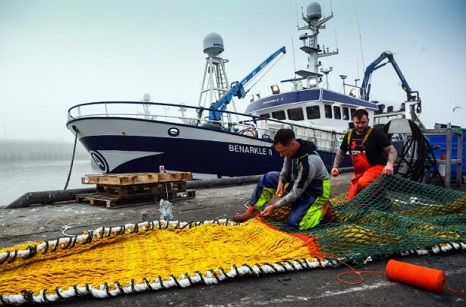
Scottish Port Feels Force Of UK Fishing Storm
In Peterhead, a major port in northeast Scotland and Europe’s largest wholesale market for white fish, Brexit was supposed to offer “a sea of opportunity” for locals. Instead they have suffered a wave of complications and added financial costs in recent years, even before the impact of surging inflation. “Careful what you wish for, it hasn’t turned out as they promised,” Mark Addison says in front of his trawler, the Benarkle II, which is moored just behind Peterhead’s fish market. “It’s been the hardest three years,” he tells AFP. “Brexit followed by the (Ukraine) war was just a double whammy.” Russia’s invasion of Ukraine sent prices soaring worldwide, with the fishing industry hit hard by rocketing fuel prices and large cost increases for key equipment such as nets. Photos. >>click to read<< 08:34
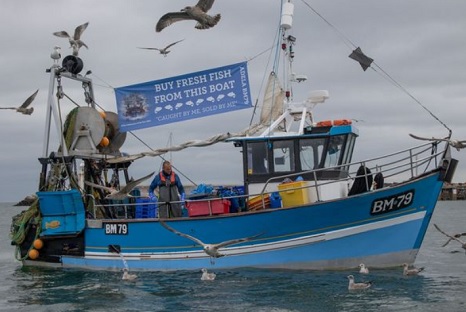
Brixham fisherman can’t trade on quay
A Brixham fisherman has described his ‘David and Goliath’ battle to sell his catch on the quayside as post-covid law changes leave him high and dry, Tristan Northway, whose boat Adela is the smallest and oldest in the Brixham fleet, was able to bring fresh fish to the quay as byelaws were relaxed during the pandemic. But now the regulations are back into force and he is driving thousands of motorway miles to sell his catch instead of selling it locally. Mr Northway presented a 763-signature petition to the council at its full meeting, calling for a review of existing byelaws to allow him and other small-scale fishermen in Torbay harbours to sell their catch directly from their boats. >>click to read<< 17:21
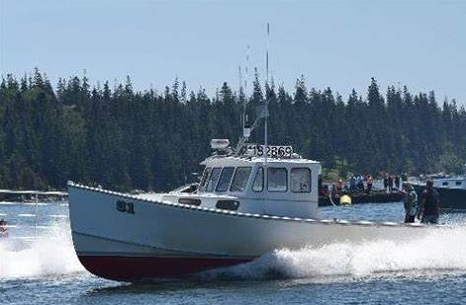
Maine Lawmaker/Lobsterman and Sternman ‘lucky to be alive’ after a “giant rogue wave” from Lee flips lobster boat
What does a lobsterman do when faced with a wall of water bearing down on him, his boat and his crew? Billy Bob Faulkingham had just finished hauling traps near Turtle Island on Friday, Sept. 15, one day before Hurricane Lee was poised to hit the Maine coast, when his 40-foot lobster boat, 51, was flipped upside down by a huge wave that seemingly came out of nowhere. “We got hit by a massive rogue wave,” he told The American. “It rolled my 40-foot boat like a toy and landed her on top of us. I’ve never seen anything like it.” Faulkingham survived without harm, while his sternman Alex Polk suffered a broken arm and a gash on his head. His lobster boat currently rests at the bottom of the ocean. He estimated 51 was in about 50 feet of water when the 40-foot wave struck. “God was with us,” he said. >>click to read<< 17:21

‘I can’t imagine being anywhere else’: The call of the ocean came naturally for six-year-old Petty Harbour fisherman
In the heart of the vast ocean, just off the shores of Petty Harbour, where the sun danced on the water’s surface, and the salty breeze kissed the cheeks of those who dared to venture, there came a moment that would forever be etched in the memory of six-year-old fisherman Austen Chafe. As the boat gently glided on the waves, an unexpected visitor emerged from the depths — a majestic tuna, gleaming with power and grace. In a split second, the world changed, as the tuna leaped and bestowed upon Austen a gift of seawater, laughter and an enduring love for the sea. “When that tuna splashed on me,” Austen said, his eyes sparkling with the memory, “I felt like the luckiest kid in the world. It’s moments like these that make me love the ocean even more. There’s something magical about being out here, and I can’t imagine being anywhere else.” Born into a family of fishermen, the call of the ocean was as natural as the rhythm of the tides for young Austen. Photos, >>click to read<< 09:34
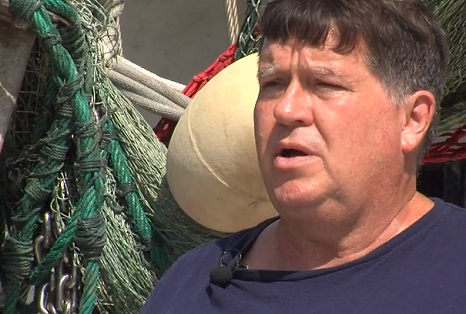
‘A Gulf and National Issue’: Southeast Texas shrimpers struggling to survive due to influx of imported shrimp
With an an influx of imported shrimp taking over the market, it’s becoming tougher for Southeast Texas shrimpers to survive. Since July 16, the Texas waters opened back up for fishing, but Eric Kyle Kimball’s boat “The Seahorse” has yet to leave the dock at the Sabine Pass Port Authority. Kimball is a third generation fisherman who’s been around the industry for 55 years. This career help provides for him and his family, with brown shrimp being the main source of income. Shrimp imported from across the globe are driving prices down from $3.75 per pound in the 80’s to 95 cents per pound, currently. After paying for fuel and deck hands, area fisherman can’t break even. Video, >>click to read<< 09:49
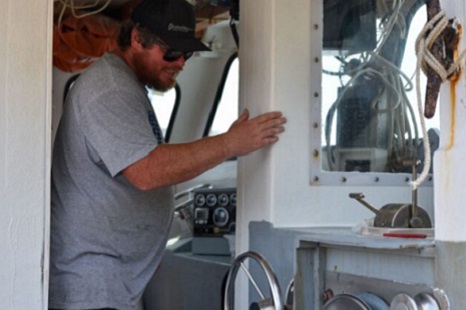
His passion is lobstering, his worry is the future
Christopher Robert Tobey Jr. was born on July 22, 1991, in Portland, into a family of fishermen. He spent a lot of time on the docks and water. He watched his father and grandfather talk with other fishermen and learned the lingo. He also learned a lot by going to other docks because everyone does things differently. “As a little kid, I always knew who everyone was and what their boat was,” he said. Tobey’s father always told him fishing wasn’t easy, but it was there if he wanted it. “I started lobster fishing because my father was a lobster fisherman, and when I was a kid that’s all I wanted to do,” he said. However, fishing is dangerous. And on May 11, 2008, Tobey’s life changed forever. “It was Mother’s Day, a Sunday, and we went out to go fishing to fill some orders for a couple of my dad’s friends,” Tobey said. “I remember it was me, my father and another fisherman, Robbie Blackburn. He was working for my dad. We went out and it was a great day and the weather started to turn.” >>click to read<< 09:53
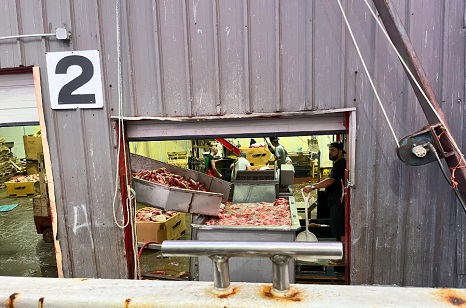
Blue Harvest to shut down, ending reign over New England groundfish
Blue Harvest Fisheries is set to shut down all fishing operations on Friday, its fishermen were told this week. It marks the last in a cascade of sales and closures for the billionaire-backed business venture that once aimed to “dominate” the New England fishing industry but ended up overcapitalized and belly up on the dock. The company launched in 2015, flush with private equity capital, and expanded at a rapid clip to become the single-largest groundfish permit holder in New England. It still owns the permits and vessels, but seafood industry sources say, after the shut down, a quick sale or bankruptcy filing is likely. “A big rise leads to a big fall,” said Luke deWildt, captain of the Teresa Marie IV, >>click to read<< 07:52
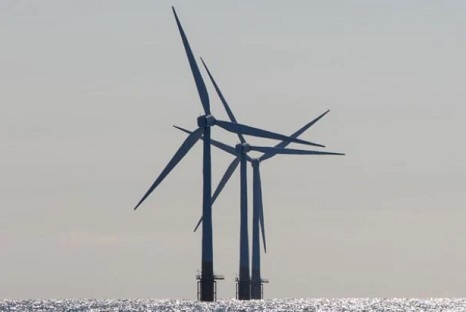
Offshore wind projects may be cancelled in NJ, according to report
Already facing a series of lawsuits and opposition from state and local officials, Danish wind power developer Orsted is reporting huge financial losses. Those losses, company officials warned, could reach $2.3 billion in the U.S and may force the cancellation of projects of the New Jersey coast. In a conference call with investors, Orsted CEO Mads Nipper told them, “If the walk-away scenario is the economical, rational decision for us, then this remains a real scenario for us.” Orsted is considering “walking away” from or cancelling projects in New Jersey, New York, Rhode Island, Connecticut and Maryland. >>click to read<< 08:48
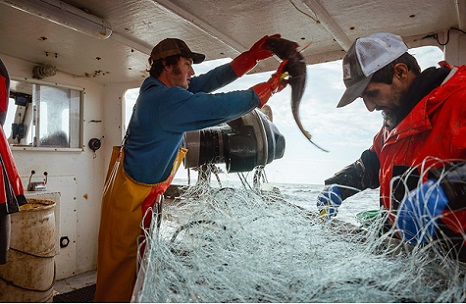
Experts fear American fishing industry, boating at risk as Biden prioritizes climate, green energy
The Biden administration has prioritized green energy at the expense of endangered whales and the U.S. fishing industry with regulation that limits both commercial fishing and recreational boating, according to experts. As they are imposing more regulations, they are also promoting offshore wind, which is actually harming commercial and recreational boating and potentially killing whales, Brady and Lapp said. “They positioned us as being these evildoers and now, 20 years later, whales are dropping dead like pigeons in Manhattan,” Brady said. “Here commercial fishermen and coastal communities are at the front line of fighting to protect the ocean itself, and we have crickets from virtually every NGO.” Video, >>click to read<< 09:09
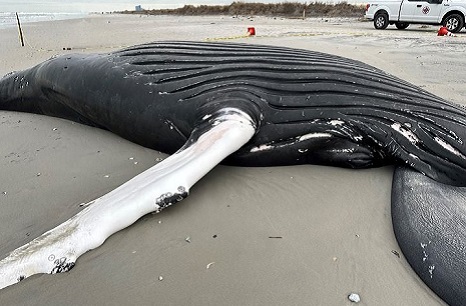
Green Groups Turn a Blind Eye to Mysterious Increase in Whale Deaths
Several environmentalist groups campaign against offshore oil and gas projects because of their ecological impacts, but those same groups appear to apply less scrutiny to the potential impacts of offshore wind developments. The Sierra Club, the League of Conservation Voters (LCV) and Greenpeace have all advocated for East Coast offshore wind projects amid the increase in whale deaths after slamming offshore oil and gas projects for their environmental impacts. The National Oceanic and Atmospheric Administration (NOAA) has declared “unusual mortality events” for humpback and North Atlantic right whales since 2016 and 2017, respectively, a timeline which generally coincides with the start of offshore wind development off of the East Coast in 2016, according to NOAA’s website. >>click to read<< 12:09
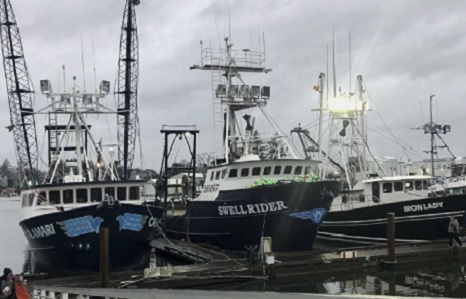
‘They’re not listening’: Fishermen, tribes voice concerns on two Oregon coast sites eyed for offshore wind farms
Last week, the Federal Bureau of Ocean Energy Management (BOEM) announced two draft Wind Energy Areas off the southern Oregon coast. One of them is offshore of Brookings, near the California border, the other off the coast of Coos Bay. The areas also represent prime fishing grounds and important cultural areas to local Indigenous tribes. Heather Mann, executive director of the Newport-based Midwater Trawlers Cooperative, said it feels like a lot of stakeholders’ concerns are being left unheard. “They’re not listening to coastal communities. They’re not listening to the fishing industry. They’re not listening to congressional representatives,” said Mann, whose organization represents 32 vessels that fish in the area. “Fishermen are not just concerned about being displaced from fishing grounds, though that is a critical piece. ” Video, >click to read< 11:35
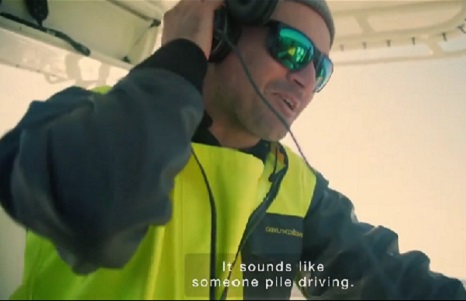
New documentary ‘proves’ building offshore wind farms does kills whales
The increase in whale, dolphin, and other cetacean deaths off the East Coast of the United States since 2016 is not due to the construction of large industrial wind turbines, U.S. government officials say. Their scientists have done the research, they say, to prove that whatever is killing the whales is completely unrelated to the wind industry. But now, a new documentary, “Thrown to the Wind,” by director and producer Jonah Markowitz, which I executive produced, proves that the US government officials have been lying. The film documents surprisingly loud, high-decibel sonar emitted by wind industry vessels when measured with state-of-the-art hydrophones. Video, >click to read<
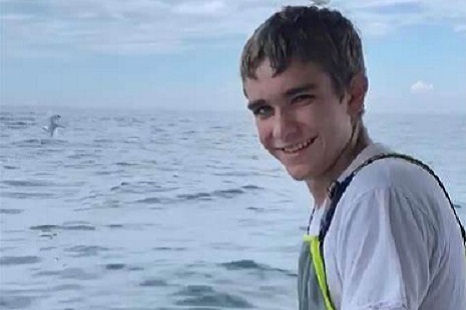
Body found in ocean Monday confirmed to be missing lobsterman Tylar Michaud
The mother of a Down East lobsterman who disappeared a month ago while fishing confirmed Thursday night that a body found in the ocean Monday morning was that of her son. Valerie Kennedy notified a Press Herald reporter that authorities have confirmed the body belongs to her son, 18-year-old Tylar Michaud, of Steuben. Kennedy declined to comment further. A Jonesport lobsterman discovered the body floating in the Atlantic Ocean near Addison on Monday morning, exactly a month after Michaud was last seen in the area. The body was taken to the Maine Medical Examiner’s Office in Augusta to be identified. >click to read< 07:54

Battery-Electric Fishing Vessel Marks a Sea Change for Small Commercial Fishers
On a brisk morning this fall, a 46-foot commercial fishing boat will cruise into the cold waters of Sitka, Alaska, and cut the diesel engine. In that moment of near silence, an electric motor will whir to life. This moment will mark a sea change for Sitka’s small-boat commercial fishing industry: a transition to energy-efficient commercial fishing, powered by low- and zero-emissions propulsion systems. The boat in question, a small commercial salmon troller named I Gotta, will make history as one of the first low-emissions fishing vessels ever deployed in Alaska. Using a unique parallel hybrid battery-diesel system, the boat can travel at full speed using its diesel engine, then switch to a battery-electric motor when fishing. In this way, I Gotta’s captain, Eric Jordan, will be able to cut the boat’s fuel use by 80%. >click to read<
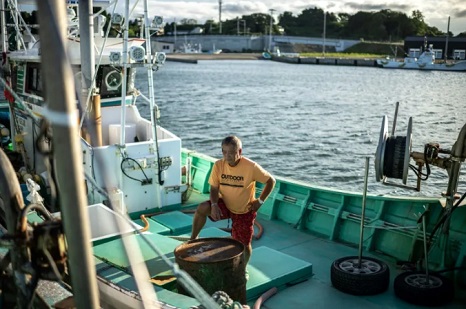
Water release finds little support in Fukushima
Most Fukushima fishermen are tight-lipped but Haruo Ono can’t keep his thoughts to himself on Japan’s plans to release treated cooling water from the stricken nearby nuclear power plant into the Pacific from Thursday. “Nothing about the water release is beneficial to us. There is no advantage for us. None. It’s all detrimental,” Ono, who lost his brother in the 2011 tsunami that crippled the plant, told AFP. “Fishermen are 100 percent against,” the 71-year-old said at his modest home in Shinchimachi, around 60 kilometres (40 miles) north of the nuclear plant in northeast Japan. “The sea is where we work. We make a living off of the sea, we’re at the mercy of the sea. So if we don’t protect the sea, who would?” >click to read< 07:43
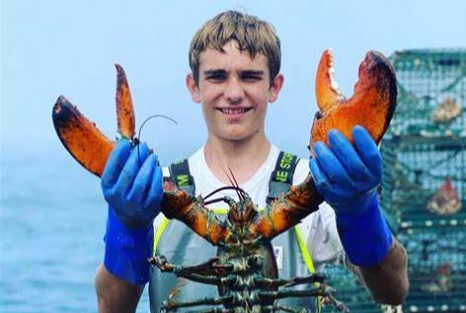
Maine lobsterman lost at sea remembered for dedication to family and friends
A Steuben teenager and lobsterman was collectively remembered for his positive attitude, wisecracks, blue eyes and bushy eyebrows when several hundred people gathered Sunday for a memorial service in a Sullivan school gymnasium. Nearly a month after Tylar Michaud, 18, went missing at sea while hauling lobster traps, and roughly 10 weeks after he graduated from Sumner Memorial High School. Michaud’s extended family, friends and members of the community gathered for a celebration of his life at the school. Michaud’s sense of humor, dedication to his family and friends, and his love of the outdoors figured prominently in their remarks. >click to read< 07:29
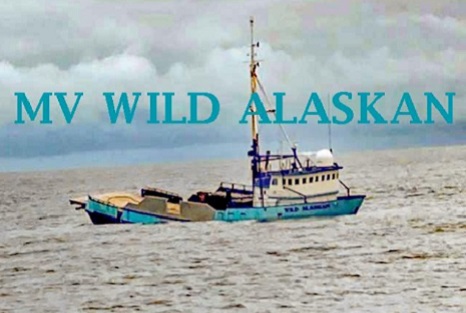
Sinking of the Wild Alaskan – Document Dump #35
It is almost comical to think that the Kodiak Daily Mirror suppressed this story for over 4 months when my lawsuit was originally filed and now that a Federal Judge has dismissed portions of my lawsuit against Federal Agents with prejudice; the Kodiak Daily Mirror which has now proven themselves to be an ankle biting lap dog of the City and the Feds rushes to print this story in yet another front-page, one-sided news article. The Kodiak Daily Mirror also wrote in the article, “Neither Byler nor U.S. Attorney Glenn James Shidner was available for comment at press time Monday.” This statement to all of our local readers in Kodiak was 100% total B.S. I was never contacted by phone, email, text message, nor on my Facebook page that now has more readers than the Kodiak Daily Mirror. Can any of you that have been following this story possibly imagine that I would not have a comment on this issue. I am going to have to give this flat out, false statement, 4 Pinocchio’s and the Publisher Kevin Bumgarner has just earned himself another photo with his clown hat at the ‘Sinking of the Wild Alaskan’ Facebook page. >click to read< 13:48
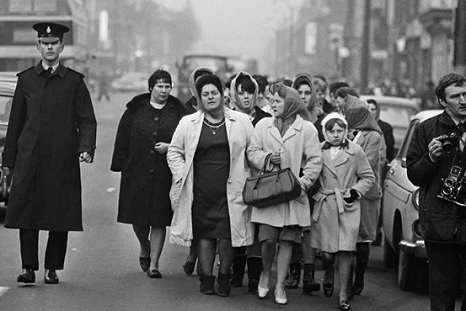
Hull tower blocks named in honour of trawler campaigner women
Three tower blocks in Hull have been renamed in honour of women who fought for new safety laws after a slew of fishing tragedies in the 1960s. Dubbed the Headscarf Revolutionaries, Yvonne Blenkinsop, Lillian Bilocca, Christine Jensen and Mary Denness changed the fishing industry for good. They took action after a triple trawler tragedy in 1968 which saw the loss of three Hull trawlers and 58 crew. Name plaques on the Porter Street flats were unveiled on Friday. The women’s campaign started when 58 fishermen lost their lives in three separate trawler sinkings in the space of less than a month in 1968. The trawlers – St Romanus, Kingston Peridot and Ross Cleveland – all sank in quick succession, and only one man survived. Photos, >click to read< 08:50
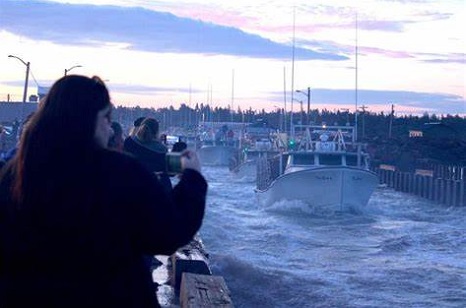
Fall fishery finally gets underway
On calm waters on a beautiful August morning, the fall lobster season in LFA 25 finally opened on Sunday following several delays due to weather conditions. The fall fishery was scheduled to open on Aug 9, but last Monday the Department of Fisheries and Ocean (DFO) decided to delay the opening until at least Aug 10 because of unfavourable forecasts. On Aug 11, it was confirmed that the LFA 25 fall lobster season would open at 6 am on Sunday, but only to set the gear. An agreement was made there would be no lobster fishing on Sunday. Photos, >click to read< 08:44






